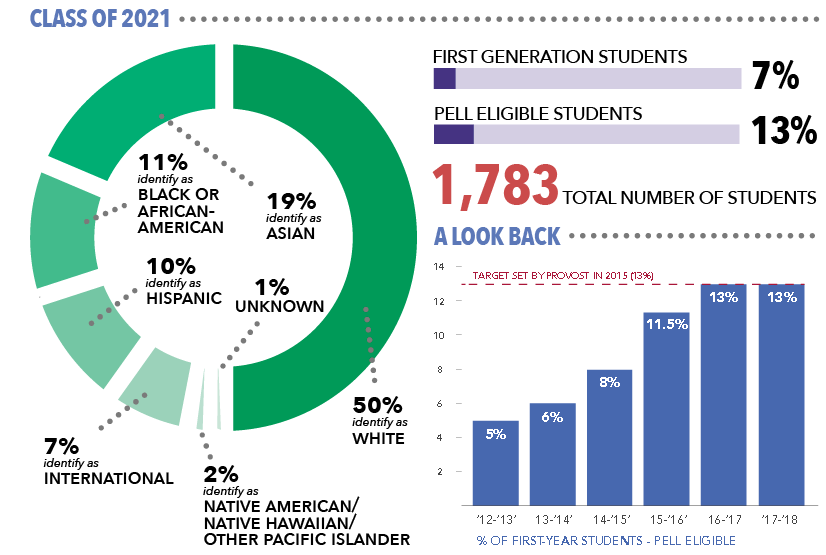Administration | News
First-year numbers see no major change
First-year numbers see no major change Incoming class reflects continued push for low-income, minority students
Washington University’s class of 2021, in many ways, appears strikingly similar to its predecessor.
Like the class of 2020, underrepresented students of color compose 22 percent of the class of 2021, while Pell grant-eligible students make up 13 percent of the class, and seven percent are first generation college students, according to Director of Admissions Julie Shimabukuro.
 Graphic by Noa Yadidi and Maddie Wilson
Graphic by Noa Yadidi and Maddie Wilson While the total percentage of underrepresented students of color remains stagnant from the class of 2020, the breakdown of individual ethnic groups within that figure has changed slightly. Twelve percent of last year’s freshmen were African-American and 9 percent Hispanic, compared to the 11 percent of this year’s freshmen class who are African-American and 10 percent who are Hispanic. Of the remaining students in the class of 2021, 50 percent are white, 19 percent are Asian, 7 percent are international students, 2 percent are Native American/Native Hawaiian/Pacific Islander and 1 percent are unknown.
This year, nearly 30,500 students applied for admission, an uptick from last year’s figure of 29,197. The incoming 1,783 first year students hail from 19 countries and all states with the exception of North Dakota, compared to the 1,780 in last year’s class who represent 25 countries and all 50 states. More incoming freshmen than anticipated, particularly underrepresented students of color, demonstrated “summer melt,” the name for when an applicant pays an enrollment deposit and then later chooses to matriculate to a different university.
“There’s so much complexity when it comes into recruiting and enrolling the type of class that an institution wants to enroll. First, it has to do with the students who are applying. Are students applying who are a good match academically and personally and socially to the institution?” Vice Provost for Admissions and Financial Aid Ronne Turner said. “And then, it’s those students feeling like the institution they’ve been admitted to is a good match for them, and they feel like they want to grow and be successful there.”
In the summer of 2015, the University announced its intention to increase the percentage of Pell grant-eligible students—those whose income level qualifies them for a federal subsidy—from five percent to 13 percent by 2020. This would require the admission of at least 13 percent Pell-eligible students for four consecutive years, a goal which has made steady progress with the classes of 2020 and 2021.
This year, the University is also waiving the application fee for Pell-eligible students and allowing them to self-report test scores, which will later be verified, to avoid the associated submission costs.
As Washington University welcomes increased percentages of Pell-eligible students, it continues to draw attention for its homogeneity. The New York Times reported in January that 22 percent of Washington University students come from the top 1 percent of the income scale, while less than 1 percent come from the bottom 20 percent. However, Turner points out that these numbers do not fully capture the University’s recent progress in fostering a diverse campus.
“Sometimes, when you’re out, and you’re more direct, and you say, ‘we want more first generation students, we want more Pell-eligible students,’ and we’re working with guidance counselors, and we’re working with [Community Based Organizations], and we’re going to different high schools than we might have done previously, then that also helps,” Turner said.
The University is also investing in programs such as the College Advising Corps (CAC), which trains recent Washington University graduates to serve as full-time college advisors in one of six local area high schools. CAC members mentor students, host college fairs and discussions about the importance of college, assist with applications, scholarships and financial aid forms and communicate with parents. CAC served at least four members of the class of 2021.
Director of the College Advising Corps Ashley June Moore, a Washington University alumna and first generation college student, acknowledges the importance of impact of college access initiatives for St. Louis-area students.
“Becoming a more diverse institution doesn’t happen in a vacuum. Programs like the College Advising Corps are striving to tangibly demonstrate the University’s commitment to being a good neighbor within the broader St. Louis community,” Moore said. “Even though CAC doesn’t specifically recruit to Wash. U., as we continue to strengthen these community partnerships, I believe more underrepresented students from high schools in our own backyard will see Wash. U. as a viable option.”
Turner emphasizes that by offering these community outreach programs, the University sends a message about its commitment to welcoming students from many backgrounds.
“There’s a lot of stuff that we’re constantly looking at within higher education to make access to the opportunities that we have more reasonable and to create more opportunities,” Turner said. “When you look at a place that is as wonderful as Wash. U. and as selective as Wash. U., Wash. U. very much wants to be reflective in some ways of the United States and our society.”
Editor’s Note: This article has been updated to reflect Ashley June Moore’s middle initial.
